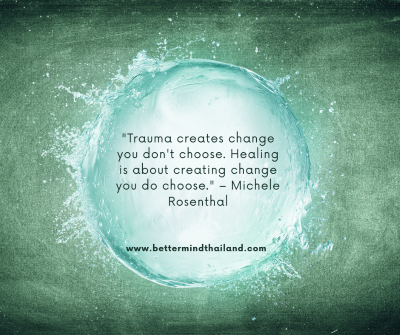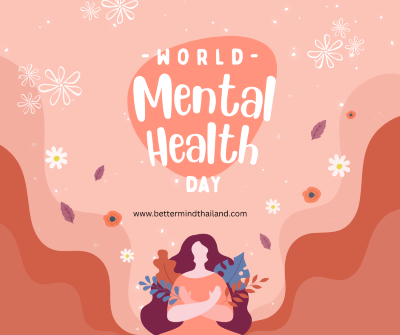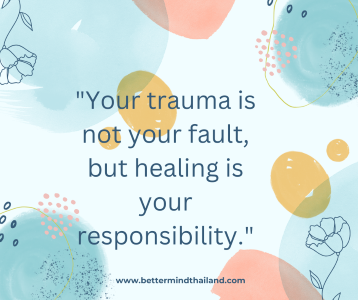Untreated Traumatic Wounds: Can We Really Live With Them?
1266 จำนวนผู้เข้าชม |

Untreated Traumatic Wounds: Can We Really Live With Them?

By Dr. Marid Kaewchinda (Ph.D.)
Counseling Psychologist | EMDR Psychotherapy | Brainspotting Practitioner
BetterMind Thailand
Many people believe that “time heals everything.”
But when it comes to emotional wounds—especially those caused by trauma—time alone may not be enough.
Unhealed wounds can silently affect how we think, feel, and connect with others.
They shape our reactions, our relationships, and even our sense of self.
This article explores what happens when emotional wounds remain untreated—and how therapy, especially EMDR (Eye Movement Desensitization and Reprocessing) and Brainspotting, can help restore emotional balance and inner peace.
What Is an Emotional Wound?
An emotional wound (or psychological trauma) is an inner injury caused by painful experiences such as neglect, loss, rejection, betrayal, or abuse.
While physical wounds may heal with time, emotional wounds often stay buried, reappearing as anxiety, sadness, fear, or self-doubt.
Some signs of untreated emotional wounds include:
- Difficulty trusting others
- Repeating unhealthy relationship patterns
- Emotional numbness or overreaction
- Chronic stress or sleep problems
- Feeling unworthy or “not good enough”
Unhealed trauma doesn’t just live in the mind—it’s stored in the body and nervous system.

What Happens If Emotional Wounds Are Left Untreated?
When trauma is not processed, the brain keeps replaying it as if it’s still happening.
You may find yourself triggered by situations that seem unrelated, feeling the same fear or pain again and again.
Over time, untreated trauma can lead to:
- Depression and anxiety
- Emotional burnout or chronic fatigue
- Difficulty in relationships
- Loss of motivation and joy
- Healing doesn’t mean forgetting what happened.
It means learning to live without being controlled by the pain.

How EMDR Therapy Helps Heal Trauma
EMDR Therapy (Eye Movement Desensitization and Reprocessing) is a proven psychotherapy method that helps the brain reprocess painful memories.
Through guided eye movements or bilateral stimulation, EMDR helps the brain safely reframe and integrate traumatic experiences.
During EMDR, the brain is encouraged to “digest” emotional pain that was previously stuck.
Clients often report that memories become less painful, emotions feel lighter, and they regain confidence and calmness.
Brainspotting Therapy, another powerful approach, helps clients access and release deep emotional blockages stored in the body by focusing on eye position and bodily sensations.
Together, these methods help the nervous system restore safety, calm, and emotional resilience.

The Path Toward Healing
Healing emotional wounds requires patience and compassion toward oneself.
There’s no universal timeline—each person’s healing journey is unique.
Some clients feel progress after a few sessions, while others may need more time to rebuild trust and safety.
The most important thing is to not face your pain alone.
A supportive therapist provides a safe space to process emotions, rebuild self-worth, and learn healthier ways to connect with others.

Final Thoughts
You don’t have to live forever with the pain of untreated wounds.
Healing is possible—step by step, layer by layer.
When you begin to listen to your inner world with kindness and professional support, your mind naturally moves toward wholeness and peace.
Because healing isn’t about erasing the past—it’s about reclaiming your present.

FAQ: Healing from Emotional Wounds
1. What causes emotional wounds?
Emotional wounds are caused by distressing or painful events such as loss, neglect, abuse, or betrayal.
These experiences can overwhelm the brain’s ability to process them, leaving lasting imprints in memory and emotion.
2. Can we live with emotional wounds without treatment?
Some people can cope temporarily, but unhealed wounds often resurface as emotional pain, anxiety, or unhealthy relationship patterns.
True healing occurs when you process the wound—not avoid it.
3. How does EMDR therapy help heal trauma?
EMDR helps the brain safely reprocess distressing memories using eye movements or bilateral stimulation.
It reduces emotional intensity and allows the memory to be stored without triggering pain, helping clients feel calmer and more in control.
4. How long does trauma healing take?
It depends on the person and the depth of the wound.
Many clients begin noticing changes within 6–12 sessions, but deeper traumas may take longer.
Consistency and trust in the therapeutic process are key to sustainable healing.
5. When should I seek help from a psychologist?
If you often feel emotionally overwhelmed, anxious, or notice that your relationships and daily life are affected, it’s time to reach out for professional support.
Seeking therapy isn’t a sign of weakness—it’s a sign of self-awareness and strength.
6. Is EMDR therapy safe?
Yes. EMDR is a safe, evidence-based therapy conducted by trained mental health professionals.
It allows trauma processing to happen gradually, ensuring emotional safety throughout the process.
7. What if I don’t know where to start?
Start by talking with a psychologist you trust.
Sometimes, the first step toward healing is simply being heard.
From there, you and your therapist can find the most suitable approach—whether EMDR, Brainspotting, or other therapeutic methods—to help you rediscover your inner strength.








